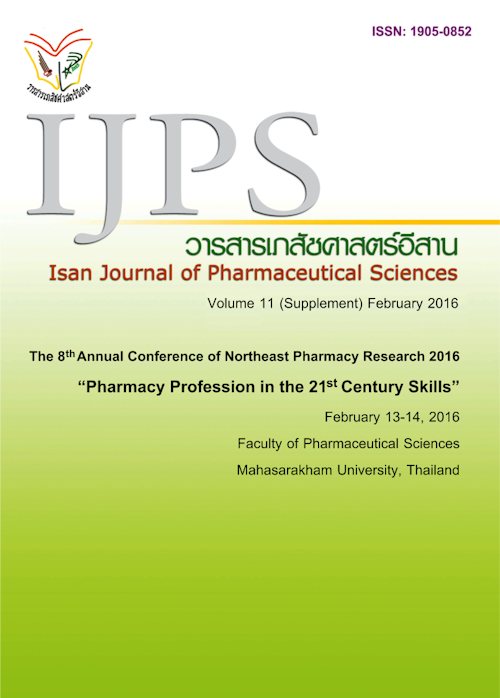The use of glutathione for whitening skin among UbonRatchathani University students according to the theory of planned behavior
Main Article Content
Abstract
Introduction: The glutathione consumption for whitening skin gain popularity among university students according to the value of beauty and whiteness in Thai society. The objectives of this study were to investigate knowledge of glutathione and to apply the theory of planned behavior (TPB) to predict the use of glutathione product behavioral intention. Methods: A cross-sectional descriptive study was conducted. Data were collected in 4 classes during the first semester of academic year 2015 by a developed questionnaire according to TPB. Descriptive statistics were used to report participants’characteristics and TPB constructs. Multiple linear regression were used to investigate the association between the use of glutathione product behavioral intention and 1) attitude towards behavior, 2) subjective norms concerning behavior, 3) perceived behavioral control, 4) knowledge, and 5) gender with the significant level (α) of 0.05. Results: Three hundred and sixty eight Ubon Ratchathani University students were willing to participate in this study. Most were female (82.9%).About one-third have ever used glutathione product (34.8%). They had average glutathione knowledge score as 5.0 ± 2.3 (mean ± SD) out of 10 points. Most obtained glutathione information via internet and TV (91.3% and 67.2% respectively). The application of TPB showed that the participants had medium attitude toward behavior, low subjective norms and medium perceive behavioral control. However, all three TPB constructs were significant factors to predict the use of glutathione for whitening skin behavioral intention (Model R2= 0.311). Analyzing gender as an additional factor indicated that gender also was a significant factor to predict Intention (Model R2= 0.324). Female had higher intention to use glutathione for whitening skin than male. Over all attitudes were the most significant construct variable to predict behavioral intention in this study. Conclusion: Findings suggested that two main strategies to promote good skin care behavior among university students should be the development of media literacy skill for consumer and the enforcement of advertising laws for glutathione products.
Article Details
In the case that some parts are used by others The author must Confirm that obtaining permission to use some of the original authors. And must attach evidence That the permission has been included
References
Ajzen I. Constructing a TPB Questionnaire: Conceptual and methodological considerations. [online]. 2006 [cited 2015 Dec 31]. Available from: 2006 http://www.uni-bielefeld.de/ikg/zickajzen%20construction%20a%20tpb%20questionnaire.pdf
BruanasakJ. The whitening cream influences self andidentity of female workers [thesis master ofarts]. Bangkok: Mahidol University; 2006.
Kongwong R and ViboonWattananamkul, A study of “harmful cosmetics” usage behavior among female teenagers in UbonRatchathani Province. IJPS,2011;7(1): 76-87
Lindeman, H.L., et al. Introduction to Bivariate and Multivariate analysis. Glenview, Illinois: Scott, Foresman and Company. 1980
Raul Charlin, Carlos B. Barcaul, BermardKawaKac, et . Hydroquinone-induced exogenous ochroniosis:a report of four cases and usefulness of dermoscoyp. IJD 2008; 15(1): 85-91.
Thai FDA. Thai FDA regulation for active ingredient in amino acid nutritional supplement.[online].2006 [cited 2015Dec 31]. Available from: http://www.jsppharma.com/index.php?lay=show&ac=article&Id=539323431
Westerhof W. and Kooyers TJ.Hydroquinone and its analoques in dermatoltgy-a potential health risk.JCD 2005; 4: 55-59.


